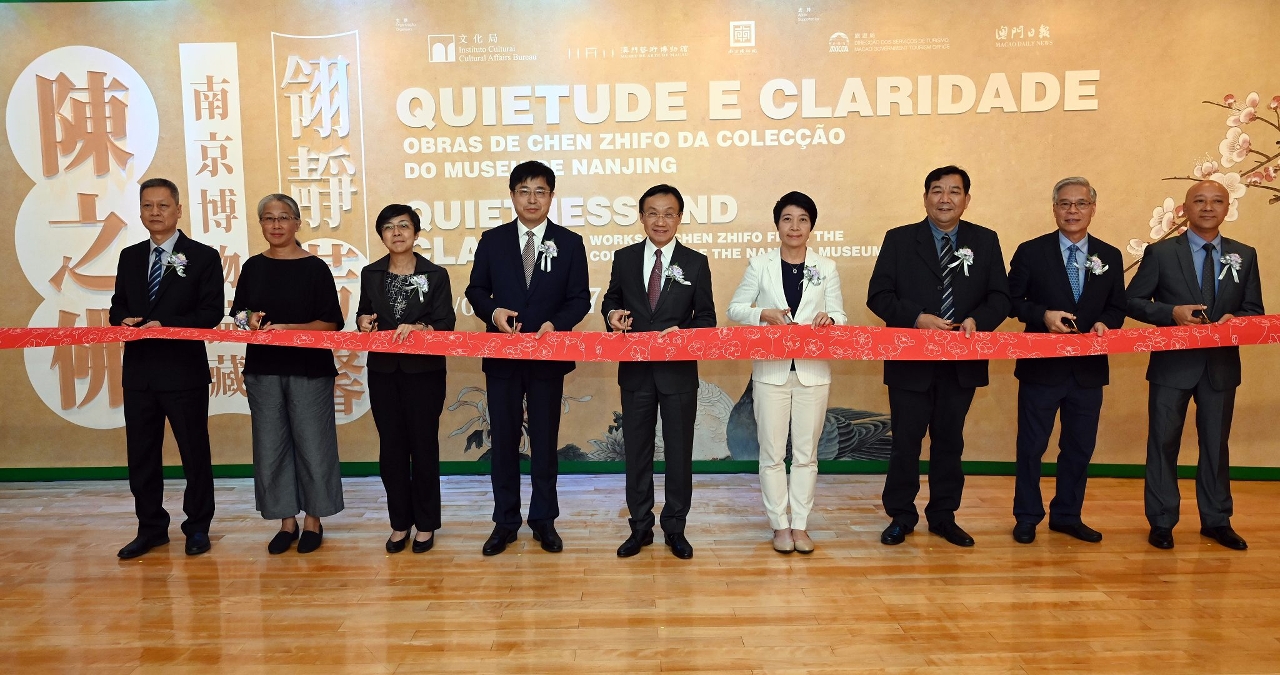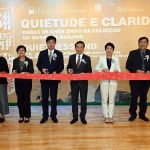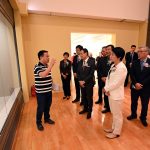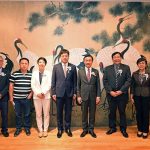 “Art Macao” introduces the artistic world of Chen Zhifo in an exhibition of bird-and-flower paintings at Macao Museum of Art
“Art Macao” introduces the artistic world of Chen Zhifo in an exhibition of bird-and-flower paintings at Macao Museum of Art
In order to strengthen cooperation and exchange of cultural institutions of Macao and Nanjing, the Macao Museum of Art (MAM), under the auspices of the Cultural Affairs Bureau, and the Nanjing Museum jointly organize the exhibition “Quietness and Clarity: Works of Chen Zhifo from the Collection of the Nanjing Museum”. The opening ceremony of the exhibition was held on 23rd August, at 6:30pm, at the Special Exhibition Gallery on the 4th floor of MAM and was officiated by the Secretary for Social Affairs and Culture, Alexis Tam Chon Weng; the Director of the Department of Publicity and Culture of the Liaison Office of the Central People's Government in the Macao S.A.R., Wan Sucheng; the Acting President of the Cultural Affairs Bureau, Leong Wai Man; the Director of the Macao Government Tourism Office, Maria Helena de Senna Fernandes; the Deputy Director of the Nanjing Museum, Li Minchang; the Acting Vice President of the Cultural Affairs Bureau, Lau Fong; the Executive Vice President of the Yu Un Chinese Calligraphers and Painters Association of Macao; Sio Chun Iun; the Vice President and General manager of the Macao Daily News; Wan Nang Hon; the President of the Macau Artist Society, Lok Hei.
This exhibition is a main programme in celebration of the 20th anniversary of the establishment of the Macao Museum of Art under the Cultural Affairs Bureau and one of the highlighted programme of “Art Macao”, featuring a total of 166 works, including paintings, sculptures, sketches, manuscripts and painting tools by Chen Zhifo, a master of Chinese gongbi (meticulous) bird-and-flower paintings, an art educator and a pioneer of Chinese modern applied arts in the 20th century. The rich variety of works offers a multifaceted introduction to his artistic world, allowing visitors to appreciate the unique characteristics of his bird-and-flower paintings, as well as his creative thinking and remarkable artistic evolution.
Chen Zhifo (1896 – 1962), whose mastery is of paramount significance in the development of Chinese modern and contemporary bird-and-flower paintings, is an expert in Chinese painting theory embracing both Eastern and Western cultures with his profound knowledge. Chen attached great importance to natural beauty and embraced ancient and new techniques alike such as using patterns with a decorative flair and integrating the gracefulness of Japanese paintings, thus bestowing his works with a sense of tidiness, realism, elegance and brightness. His gongbi bird-and-flower paintings revived the genre after its long decline since the Ming and Qing dynasties, adding useful experience and elements to Chinese modern arts in the course of transition.
In order to further introduce the public to Chen’s achievements in pattern design and gongbi bird-and-flower paintings, the Macao Museum of Art will hold a number of educational activities including thematic talks on 1st and 14th September, 2019 and 12th October, 2019, two bird-and-flower embroidery workshops, courses related to exhibition, concerts and thematic guided tours. Admission is free for the activities.
The exhibition “Quietness and Clarity: Works of Chen Zhifo from the Collection of the Nanjing Museum” is held from 24th August, 2019 to 17th November, 2019. For more information about the exhibition and activities, please visit the MAM website at www.MAM.gov.mo. The Macao Museum of Art, located at Avenida Xian Xing Hai, NAPE, is open daily from 10am to 7pm (no admittance after 6:30pm), including public holidays and is closed on Mondays. For enquiries, please contact MAM through tel. no. 8791 9814 during opening hours.




